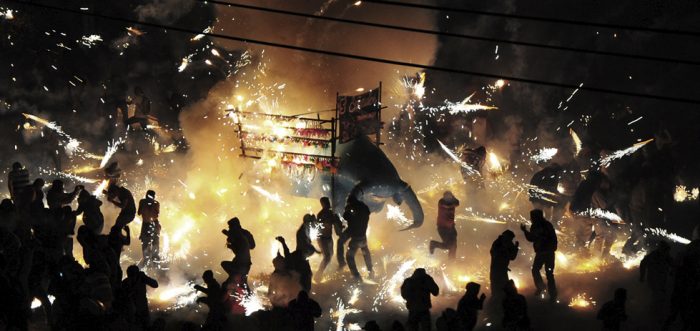
Viktor Jakovleski’s IMDb page makes for fascinatingly eclectic reading: he is credited as Eric Bana’s driver on Hanna (2011), as George Clooney’s assistant on The Monuments Men (2014), and as a producer on the music video for MGMT’s hit single “Electric Feel” (2007). This varied array of roles belies the singular focus of his debut documentary, an intermittently poetic and immersive portrait of explosive transcendence. Brimstone & Glory observes the weeklong preparations and festivities as the city of Tultepec — which a title card informs us is Mexico’s fireworks capital — hosts the National Pyrotechnics Festival. The annual event, held in March, sees locals assembling homemade fireworks which are set off at night to honour Juan De Dios, a Catholic saint who founded the Hospitaller Order of the Brothers of Saint John of God in 1572 and who is colloquially known for a story in which he rescued inmates from a fire in Granada’s Royal Hospital in 1549. We’re told that the festival encompasses two events: the Castles of Fire and the Burning of the Bulls. These names rightly suggest some kind of apocalyptic medieval horror, but here they function as the first of a series of dualisms that structure the film.
In terms of its content, the film cross-cuts between daylight sequences of the fireworks preparation and assembly, and the actual fireworks displays at night. Stylistically, too, there’s a clearly delineated divide: the sinuous camera roams the streets by day, a wide angle lens keeping everything in focus. At one point, a GoPro is strapped to someone’s head as they climb up one of the towering Castles of Fire to affix fireworks. Once night falls and the fireworks blast off, the film adopts stylised slow motion. The Castles of Fire shoot off batteries of fireworks into the sky, and enormous multi-coloured papier mâchéd bulls, one replete with dangling testicles, are run through the streets by whole families, firing off fireworks in all directions — some to start fires on the ground, or hit young men in the eye.
If the film has a notable misstep, it is in Dan Romer and Benh Zeitlin’s score. At times, their percussive cuts add a propulsive energy to the procedural depictions of the fireworks’ assembly, but their more grandiose post-rock gestures come close to overwhelming — and thus diminishing the power of — the film’s more lyrical depictions of the fireworks displays themselves. The footage itself is so strong that it’s frustrating director Jakovleski wasn’t confident enough in the power of his images to speak for themselves. In his association with the film (also as producer), Zeitlin continues the project of his feature debut Beasts of the Southern Wild, another spectacle of slow motion fireworks displays and cross-cultural expeditions. Zeitlin is also credited on Brimstone as a camera operator, along with over ten credited cinematographers and camera operators, including Jakovleski and principal cinematographer Tobias von dem Borne.
The film’s visual style emphasises the transcendent spectacle of, well, blowing shit up. We never really get to know any of the participants on an individual level, and in this regard the film serves as an illustrative departure from the recent short IEC Long (João Rui Gerra da Mata and João Pedro Rodrigues, 2015). That film also looked at the presence of fireworks within a specific cultural context in Macau, but struck a more introspective tenor, exploring history and tradition. In Brimstone & Glory, glimpses of interviews are rapidly intercut with procedural shots of interviewees assembling fireworks, while a disembodied chorus of voices come and go on the soundtrack, offering fragmentary thoughts on the importance of the event, of the risk of occasional deaths. Beyond this, the film never really explores the social context of the festival, offering only implications: a man, missing a hand, assembles fireworks, and children speak of wearing their scars with pride as bloodied men stagger off for makeshift medical attention. For those looking for a deeper allegorical reading, it might be found in the spectacle itself. Night falls, obscuring the humdrum surroundings, the stucco buildings marked “peligro”. Then the fireworks light up the sky, momentarily illuminating the joyous faces of onlookers.
